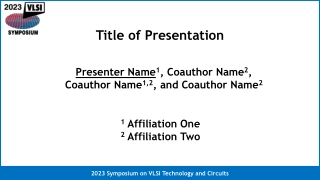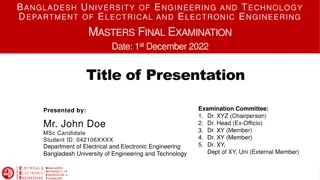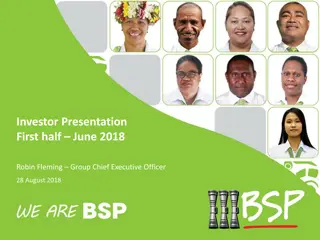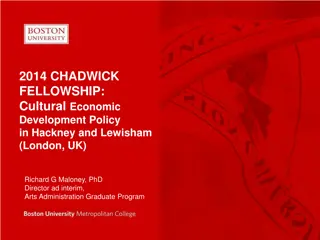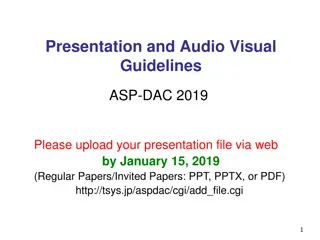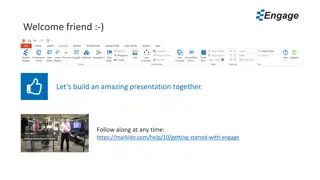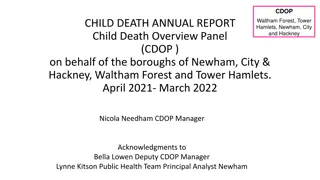Young Hackney Integrated Early Help Services Overview
Young Hackney, the integrated Early Help service of Hackney Council, aims to support young people aged 6-19 (up to 25 with SEND) in enjoying their youth and becoming independent adults. It provides access to various opportunities and services in the community, combining universal and targeted services like youth, play, sports, health, wellbeing, crime prevention, and more. Their Prevention & Diversion program works with young individuals involved in antisocial behavior or low-level crime. The approach emphasizes restorative practices, trauma-informed care, and data-driven practice development. Swiftly establishing trusted relationships, understanding victim experiences, and tailored intervention plans are key in working with young people.
Download Presentation

Please find below an Image/Link to download the presentation.
The content on the website is provided AS IS for your information and personal use only. It may not be sold, licensed, or shared on other websites without obtaining consent from the author. Download presentation by click this link. If you encounter any issues during the download, it is possible that the publisher has removed the file from their server.
E N D
Presentation Transcript
Who does Young Hackney work with and what is our aim? Young Hackney is Hackney Council s integrated Early Help service for young people aged 6 19, up to 25 if SEND. We aim to help all of Hackney s young people to enjoy their youth and become independent and successful adults and provide access to a range of opportunities and services available in the local community. Integrates universal: youth, play, sports and participation services with targeted early help and more specialist substance misuse, health and wellbeing, young carers, detached outreach and crime preventions services. Prevention & Diversion (P&D) working with young people who get involved in antisocial behaviour or low level crime and/or affected by it; helping young victims of crime & adult victims with a view to reduce offending and repair harm.
Who does YH P&D work with and what are our main features? P&D offers young people 10-18 diversionary intervention distinctly from a statutory YJ context, whilst working collaboration with police, YOT, CSC colleagues and specialist services. Our cohorts are young people between 14 and 17, predominantly male and identify as Black British, Mixed Heritage and a small percentage of other minoritized groups. This reflects overall disproportionality within the YJ system and education system (exclusions) both nationally & locally. Emphasis on youth work methodology, strength-based, restorative and trauma-informed approaches, systemic thinking, child first, anti-racist & anti-oppressive. Ease of access to universal opportunities or further targeted support as needed. Collection and analysis of quantitative and qualitative data to inform practice development & service need. in close partnership &
What are our approaches and tools with young people? Swiftly establish a trusted and open relationship. Explore views on RJ and the possibility of repairing harm; understanding own experiences of victimisation . Understand lived experiences, desistance & criminogenic factors. Culturally informed; inequality and systemic racism influence P&D s thinking and planning. Tailor intervention plans responsive to child needs and interests. In parallel, contact all victims, incorporate their views into the intervention and, whenever possible, deliver a direct or indirect restorative intervention. Consider exp of children as victims. Develop an exit strategy and follow on support as needed.
Desistance Research - What Works 1. Building professional relationships, effective engagement and re-engagement, evidence of genuine collaborative working 5. Creation of opportunities for change, participation and community integration 6. Motivating children and young people 2. Evidence of engagement with wider social contexts, especially the family, but also peers, schools, colleges, work etc. 7. Addressing children and young people s sense of identity and self-worth 8. Constructive use of restorative approaches 3. The active management of diversity needs https://www.justiceinspectorates.gov.uk/hmiprobation/wp- content/uploads/sites/5/2016/05/Desistance_and_young_p eople.pdf 4. Effectiveness in addressing key structural barriers (exclusion from education, training or employment, lack of participation, resources, substance misuse deficits, insufficiency of mental health services etc.)
P&D and Disproportionality For the last 5 years P&D cohort has consistently been 75-85% children from Black, Mixed Heritage & other minoritized backgrounds. Nationally, BME children are less likely to be diverted to OOCDs, Hackney P&D seems to buck this trend (Lammy Report & Guardian https://www.theguardian.com/society/2019/nov/04/share-convicted-children-bame-doubles). something we will continue to look at and analyse to understand any potential implications for our practice. This is Hackney Council has ambitious long-term strategies: Improving Outcomes for Young Black Men (IO4YBM) and CFS Anti-Racist Practice Plan, a favourable context to effect change. P&D data and outcomes fit into these wider strategies in that they contribute to reducing the likelihood of young Black males entering the criminal justice system and and the associated cumulative risks of poor life outcomes that this can generate.
Challenges in addressing Disproportionality (Some thoughts) Need to work with other agencies & partners with different organisational cultures, practice approaches, aims - can influence but also need to consider risk of disrupting relationship; challenge can impact collaboration & dialogue P&D mindful of factors such as mental health, education, racism, and poverty that can increase adverse outcomes for young black males. However, the frameworks in which we work sometimes leaves us with a sense of working within systems too entrenched to effect radical change. Challenge of how to maintain commitment & motivation to accountable? take anti-racist action; who is Data clearly support the existence of disproportionality across domains, but more coordinated, collaborative & sustained action at a local & national level needed Disproportionality : Same duty as safeguarding? i.e. Everybody s Business; a Duty for all agencies to interrogate, address, reduce- Legislation to this effect?
What does our local quantitative data tell us? Apr 2016 - Mar 2017 Percentage of Triages 51%; Triage Success Rate (% not converted to FTE) is 82% Apr 2017 - Mar 2018 Percentage of Triages: 60%; Triage Success Rate (% not converted to FTE) is 86% Apr 2018 - Mar 2019 Percentage: 56%; Triage Success Rate (% not converted to FTE) is 82%
What does our local qualitative data tell us? Common factors against desistance in the cohort who reoffended Common factors for desistance in the cohort who didn t reoffend Level of complexity re ACEs is consistent with yp who reoffended, strong causal link between these and offending behaviour in adolescence Complex and traumatic family experiences (domestic violence and/or abuse; SEND needs and experiences of school exclusion Participation in education Good engagement with services Responsive, supportive families Access to community resources A positive relationship with at least one primary caregiver and/or professional involvement characterised barriers and limited ability to affect change. with by services engagement Family history of involvement in offending and parental substance misuse and/or mental health
What did we learn & what will we do? In relation to factors against desistance , the combination of factors and multiple risk and vulnerability indicators not unusual in contributing to re-offending. Develop our trauma informed interventions both for individual and group work delivery. Better understanding, training and interventions aimed at helping parents affected by mental health / substance misuse / hidden harm & how these impact on young people s early childhood experiences. More collaboration with other specialist colleagues. Maintain operational & strategic focus on systemic barriers to change related to wider societal issues such as disproportionality in criminal justice education, cultural awareness and other experiences of racism/social exclusion/discrimination. In relation to protective/ for desistance factors, not enough recorded evidence citing individual factors such as personal efficacy, self-esteem, resilience, maturation and identity. Need to be capturing and considering more explicitly in our assessments, plans, interventions and evaluations the uniqueness of each young person's lived experience and characteristics. Practice tools refined to this effect e.g. assessment tool
Victims Feedback Thank you very very much for your support, professionalism, regular communications and understanding. You've made this experience smooth and as stress free as possible. Thanks again. Was so lovely meeting you and it's very reassuring to know that considered measures are being taken to help perpetrators evaluate their behaviour/actions and the consequences of that behaviour. Thank you so much for the update and feedback from the victim awareness and restorative process work you did - great to hear the positives outcomes! The support I have received from the Police and yourself is amazing. It is staggering, the amount of work that goes into what the YOT do, as a service, to support young people; the extent you all go to individually; for both victims and young offenders. interesting conversation with the Police and I felt very supported and informed. I want to extend my thanks to your team for the support that goes into restoring the community. I had a very I felt well cared for throughout the process and it was calm and well managed .
Young Peoples Feedback I took a lot from the restorative justice group work project because I learnt about the different types of harm, the impact it can have not only on the victim but others . I definitely feel like I ve turned a corner. I made a mistake and wanted to make amends and I genuinely feel like I have done this . Actually I enjoyed all of it, it made me feel better . I enjoyed talking about all my problems I had which makes me feel better, it stops me from worrying . The sessions gave me space to think about how behaviour impacts others. I enjoyed exploring different parts of my culture and identity. I enjoyed positive activities like boxing. Because working with adults who aren t judgemental makes me understand more. I enjoyed talking to the Police as it is exciting and opened my mind to other career fields. It s nice opening up to someone as nice as (worker), it s nice having conversations about my future as sometimes my friends cannot help .
Young Peoples Feedback You helping me over shoplifting to understand what I have done, I now understand what I have done and what can happen to me. I have learned a lot of new things that can help me feel smarter. It made me see the bigger picture in a lot of things, it helped me understand more. Working with (worker) she understands things and helped me work around them . It helped me learn what it did and change for it. I enjoyed learning about myself . I enjoyed learning new things, to think before I act and be patient, I felt listened to and the staff made things clear. It will prevent me from getting into trouble in the future . I learnt about the Law and feel more knowledgeable. I have developed in terms of my own moral compass, being able to look at the offence and other situations from a different perspective . Parent: She found the sessions better than expected and more relaxed in terms of being able to have open discussions about different topics. She felt supported and listened to .
THANK YOU FOR LISTENING THANK YOU FOR LISTENING


